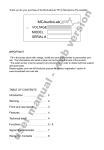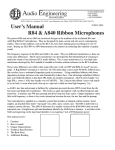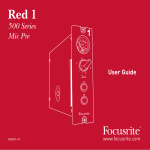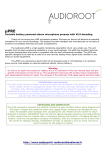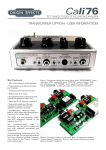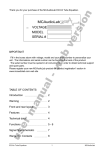Download User Manual - Spontaneous Audio Devices
Transcript
Our deepest gratitude to you for purchasing the Son of Kong, an EQ/Gain pedal and DI of massive aural proportions, elegantly designed to provide a multitude of features, functions, and tones. This pedal is the brainchild of audio architect Arthur “Midget” Sloatman. The EQ is the same circuit that Arthur installed in all of Frank Zappa’s stage guitars, which he used exclusively from 1979 on. The gain circuit provides up to 35 dB of clean, quiet gain, plus an additional 20 dB of frequency dependent EQ gain for an amp crushing 55 decibels of potential gain. In addition, the SoK provides a simultaneous DI output and an unaffected throughput, as well as a few other tricks. Please read through the “Applications” section to discover how to unlock some of the hidden mysteries of the Son of Kong. DISCLAIMER: The Son of Kong is capable of providing extreme volume levels when used with an amplifier. In order to prevent hearing damage, turn down the amplifier volume before plugging in or engaging the SoK and ESPECIALLY WHEN SWITCHING THE “DI +20” SWITCH TO THE +20 SIDE. Quick Start DI (Low Gain) Mode DI mode allows for low gain through the EQ circuit resulting in increased headroom, perfect for using the DI and for feeding additional pedals in your signal chain. Q F G Begin with Bypass engaged, the “DI +20” switch in the left position, the “Q”, “F”, and “G” controls at 12 o’clock, and “V1” set to about 1 o’clock. Refer to the picture at right. Disengage Bypass into channel “V1” and set “V1” volume knob up or down slightly until the volume is equal to the Bypass volume. This is unity gain. Notice, when switching between Bypass and “V1,” that there is a detail that is revealed when “V1” is engaged, even without adding any Gain or EQ to the signal. The “V1” gain control knob provides a modest 6 dB gain boost in DI (Low Gain) Mode when turned all the way to the right. V1 DI 𝄞 𝄢 V2 +20 EQ to V2+DI Approximate Unity Gain in DI Mode The EQ circuit is always active in channel “V1”. Turn the EQ gain control “G” to the right or left to add or subtract gain at the frequency selected. At 12 o’clock, there is no gain change. Turn the frequency control “F” to the right or left to select higher or lower frequencies. “ 𝄢 ” sets the frequency selection to bass frequencies (35 Hz to 1kHz). “ ” sets the frequency selection to treble frequencies (180 Hz to 5kHz). See graphic at right. 180 Hz 1 kHz 𝄞 Turn the bandwidth control “Q” right to narrow the frequency selection or left to widen it. Hard left is 2 octaves wide, 12 o’clock is 1 octave wide, hard right is 1/10 of an octave. Switch to channel “V2”. In DI (Low Gain) Mode, the “V2” gain control provides the same 6 dB boost as “V1”. The EQ can be engaged into the channel path by switching the “EQ to V2+DI” to the right. +20 (Hi Gain) Mode +20 Mode allows for increased gain through the EQ circuit, perfect for overdriving the signal and, as the last pedal in your chain, feeding a hot signal to an amplifier. All functions work the same as in DI mode only with higher gain stages. “V1” now provides 15 dB of gain. “V2” provides 26 dB of Gain with an additional 9 dB when the EQ is switched in. Turn the gain control “G” to the right until the signal distorts. Now tune the distortion by sweeping the frequency control “F” and bandwidth control “Q”. V1 and V2 provide post-EQ volume control. Reducing Distortion In order to reduce distortion in the EQ circuit, do one or more of the following: • Reduce the volume of your instrument into the SoK • Use a higher voltage power supply (up to 40 V DC) • Use the gain control “G” to cut frequencies, making up the gain with “V1” and “V2” (e.g., cut high frequencies rather than boosting bass). www.spontaneousaudio.com © 2013 Modern Vintage Audio, LLC | Spontaneous Audio Devices 35 Hz 𝄢 1 kHz 𝄞 Bass Selection 180 Hz 𝄢 5 kHz 𝄞 Treble Selection Controls Inputs Instrument: High impedance input 9-36V DC: 9 Volt external power supply (2.1mm, center pin negative) or internal battery recommended, however, the SoK will accept up to 40 Volts which will completely unleash the power of the SoK’s devastating gain potential with exceptional headroom for pristine transient reproduction. Outputs Out: Main unbalanced output to feed amp or additional unbalanced inputs. Throughput (Thru): Unaffected signal split from the Instrument input can feed separate amp, amp channel, or additional pedals. An internal jumper allows the throughput to mute when “V2” is engaged (see Amp and Channel Switching in the Applications section). DI Out: Exceptionally musical Lundahl transformer-balanced output can go directly to microphone preamp or other balanced input with or without EQ. By default, the DI is deactivated when Bypass is engaged to allow for true hardwire bypassing. An internal jumper allows the DI to always be active regardless of the bypass state by placing electronics inline. For those using the DI output, changing the “TRUE B/P” jumper to “NO” is recommended. For those not using the DI output, leaving the “TRUE B/P” jumper set to “YES” is recommended. Functions Q: Variable super-wide to super-narrow bandwidth allows for everything from smooth and subtle tone control to funky and gnarly frequency mangling. F: Frequency is fully sweepable from 35 Hz to 5 kHz according to the range switch. G: 20 dB boost or cut. No cut or boost at the 12 o’clock position. V1: Channel 1 volume control is Post-EQ with +6 dB gain in DI (Low Gain) Mode or +15 dB gain in +20 (Hi Gain) Mode. V2: Channel 2 volume control is Post-EQ with +6 dB gain in DI (Low Gain) Mode or +26 dB gain in +20 (Hi Gain) Mode. DI to +20 Switch: Towards DI enables the DI output and sets the SoK in Low Gain Mode. Towards +20 sets the SoK in High Gain Mode and enables the 20 dB boost at V2 while disabling the DI output. Range Switch: Switches the usable range of the frequency control as indicated below 𝄞 : Treble range from 180 Hz to 5 kHz. 𝄢 Bass range from 35 Hz to 1 kHz. EQ to V2 + DI: Switch to the right to insert the EQ circuit into the Channel 2 (V2) and DI signal paths. The EQ is always in the Channel 1 signal path regardless of the switch position. • In “DI” Mode, this switch presents unity gain to the DI and V2 signal paths when inserted. • In “+20” Mode, this switch adds 9dB additional gain into the DI and V2 signal paths when inserted. Bypass Switch: Bypasses all gain and EQ. Active when LED is lit. V1/V2 Switch: Switches between Channel 1 signal path and Channel 2 signal path as indicated by the corresponding LEDs. Internal Jumpers TRUE B/P: The SoK ships with True Bypass jumper set to the “YES” position. This completely removes all electronics from the circuit path and deactivates signal to the DI output when Bypass is engaged. Switch the internal jumper to “NO” to allow the DI to remain active when Bypass is enabled. This leaves active electronics in the Bypass signal chain. For those using the DI output, changing the “TRUE B/P” jumper to “NO” is recommended. For those not using the DI output, leaving the “TRUE B/P” jumper to “YES” is recommended. THRU MUTE: The SoK ships with the Thru Mute jumper set to “OFF” allowing signal to always be present at the throughput when either V1 or V2 is selected. Set the Thru Mute jumper to “ON” to enable the throughput to mute when V2 is selected. Enabling the throughput to mute on V2 selection allows you to use the SoK as a channel or amp switcher (see “Amp Switching” in the Applications section). www.spontaneousaudio.com © 2013 Modern Vintage Audio, LLC | Spontaneous Audio Devices Applications EQ and Gain Switching The SoK can be used simply to switch between your direct guitar amp sound in Bypass, to an EQ’d boost in V1, to a super boosted signal (with or without EQ) in V2. The channels can also be configured to have matched gains by turning down the channel volumes. Switch between bypass and V1 without adding EQ or Gain and notice how the SoK brings out more depth and detail just by passing through it. EQ Distortion The EQ circuit can be clipped to create a pleasing distortion. Turn the EQ gain fully clockwise, then tune your distortion by sweeping the frequency and widening or narrowing the Q to achieve a variety of distortion sounds - from big, thick and heavy to sharp and nasal. Use the Channel gain to set your post-distortion level. Back off the EQ gain to reduce the amount of saturation. Q F G EQ Distortion Amp Switching The SoK can be used to switch between amps by utilizing the Throughput. By default, the Throughput is always active. Set the internal THRU MUTE jumper to ON. Now, In V1, both the Throughput and the Main Output are active while in V2, the throughput mutes when leaving only the Main Output active. By turning V1 fully counter-clockwise, when V1 is selected only the throughput will send signal and, when V2 is selected, only the Main Out will send signal. This gives you the following: V1: Amp 1 with unaffected Throughput signal (Main Output turned down). V2: Amp 2 with Main Output signal (Throughput muted) Channel Switching Same as Amp switching but using 2 channels on the same amp. Switch between clean and distortion, rhythm and lead, dry and tremolo, etc. V1 can be turned up to allow both channels to receive signal simultaneously. See Trem Chorus below. Amp Switching Trem Chorus Using a 2 channel Amp with tremolo, send the Main Output of the SoK to the Dry channel and the Throughput to the Tremolo channel. Set the tremolo to mid speed, mid-depth. Set the EQ to a low mid boost. With Channel 1 engaged, turn V1 gain all the way down. You should hear only the tremolo channel (Throughput) when you play. Start bringing up the V1 gain until you hear the two channels phasing with each other. It is possible to achieve Leslie rotor type sounds this way. This happens because the EQ’d circuit is naturally out of polarity with the throughput which causes comb filtering. Note that some amps have 2 channels that are already out of polarity with each other. In this case, you will not hear this effect as the two channels will be flipped back into polarity. Gain 1 Tremolo Trem Chorus Frequency Tuning Frank Zappa often tuned his guitar to the room’s natural resonance to invoke room shaking sustain. Do this by presetting a narrow Q, high boost at the room’s resonant frequency (sweep the bass Frequencies till you find it). Likewise, you can tune the EQ to any single note that will have huge sustain when you hit it. Insert Send The SoK can be used as an insert effect on a channel strip of a mixing console. Use an unbalanced Insert Send into the Instrument input of the SoK. Use the EQ to mold, sweeten, and distort vocals, guitars, or other signals. Use the V1 or V2 volume controls to increase or decrease the output level to match the input level. Return the signal back to the Insert point from the Main output of the SoK. Q F G Frequency Tuning Changing the Battery and Jumpers Be careful not to break any cable connections when opening the SoK. Remove the four screws that hold the SoK enclosure together. Lift the top straight up and over the back, laying it on its face directly behind the base. Replace the battery and move the jumpers as labeled on the circuit board. Warranty This product is warranted against defect in parts and labor for one year after the date of purchase. To register your product and receive service, please contact us at [email protected] with “Register” as the subject. Please include your name, contact number, a copy of the purchase receipt with purchase date, location of purchase, and the product serial number (can be found inside by the battery). All external fixtures, finishes, and knobs are not warranted. Damage or failure of product due to misuse voids the warranty. All repairs must be made by Spontaneous Audio Devices or an SAD authorized technician. Unauthorized repair or modification voids the warranty. www.spontaneousaudio.com © 2013 Modern Vintage Audio, LLC | Spontaneous Audio Devices Meet Son Of Kong Guitar Tone Guide Here are some tones to use as a starting point. “G” knob (Gain) settings to the right of 12 o’clock are EQ boosts. Settings to the left are EQ cuts. The farther away the knob moves from center, the more drastic the tone shaping. Use the blue knobs (V1 and V2) like a master volume. Tweak the “F” (Frequency) and “Q” (Bandwidth) knobs to fine tune the tone. 2. Bright Country Clean 1. Clean Strat from Humbucker Q F V1 DI +20 Q V2 F V1 EQ to V2+DI 𝄞 𝄢 G 3. Classic Rock DI +20 V2 Suggested Amp audition volume: 3-5 Suggested Amp audition volume: 3-5 4. Mid Scoop 5. Woman Tone Q F V1 DI 𝄢 𝄞 +20 G Q V2 EQ to V2+DI Suggested Amp audition volume: 3 DI 𝄢 𝄞 +20 F V1 DI +20 V2 EQ to V2+DI 𝄞 𝄢 G Suggested Amp audition volume: 3 6. Boston/Money For Nothing F V1 Q EQ to V2+DI 𝄞 𝄢 G G Q V2 V1 EQ to V2+DI Suggested Amp audition volume: 3 F DI 𝄢 𝄞 +20 G V2 EQ to V2+DI Suggested Amp audition volume: 3 CAUTION!! THE FOLLOWING TONES ARE LOUD. TURN DOWN YOUR AMP AND TURN IT UP SLOWLY TO AVOID DAMAGE TO YOUR EARS, WALLS, FURNITURE, WIVES AND CHILDREN!! 8. Amp Decimator 7. Jimi Fuzz Q F V1 DI 𝄢 𝄞 +20 G V2 F V1 EQ to V2+DI Suggested Amp audition volume: <2 www.spontaneousaudio.com Q DI 𝄢 𝄞 +20 9. Sub-Octave Fuzz G V2 EQ to V2+DI Suggested Amp audition volume: <2 © 2013 Modern Vintage Audio, LLC | Spontaneous Audio Devices Q F V1 DI 𝄢 𝄞 +20 G V2 EQ to V2+DI Suggested Amp audition volume: <2 Meet Son Of Kong Bass Tone Guide 2. Big Bottom 1. Rich Scooped Bass Q F V1 DI 𝄢 𝄞 +20 G Q V2 F V1 EQ to V2+DI 3. Slap Tone DI 𝄢 𝄞 +20 G V2 Adjusted for Unity Gain. For DI users, switch to DI Mode 4. Motown Bass 5. Bright Attack F V1 DI 𝄢 𝄞 +20 G V2 Q EQ to V2+DI Adjusted for Unity Gain. For DI users, switch to DI Mode DI 𝄢 𝄞 V1 +20 DI 𝄢 𝄞 +20 G V2 EQ to V2+DI Adjusted for Unity Gain. For DI users, switch to DI Mode 6. Vintage Bass Drive* F V1 F EQ to V2+DI Adjusted for Unity Gain. For DI users, switch to DI Mode Q Q G V2 Q F V1 EQ to V2+DI Adjusted for Unity Gain. For DI users, switch to DI Mode DI 𝄢 𝄞 +20 G V2 EQ to V2+DI *Caution! Turn your amp down. This sound not recommended for DI. Design Your Own Q F V1 DI 𝄢 𝄞 Q +20 DI 𝄢 𝄞 Q V2 +20 G V2 DI 𝄢 𝄞 Q +20 DI 𝄢 𝄞 G Q V2 +20 G V2 EQ to V2+DI © 2013 Modern Vintage Audio, LLC | Spontaneous Audio Devices F V1 EQ to V2+DI F V1 EQ to V2+DI www.spontaneousaudio.com F V1 EQ to V2+DI F V1 G DI 𝄢 𝄞 Q +20 DI 𝄢 𝄞 V2 EQ to V2+DI F V1 G +20 G V2 EQ to V2+DI






